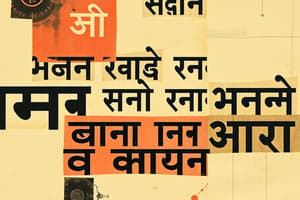Podcast
Questions and Answers
Devanagari script is used in Hindi, a language spoken by over 430 million people worldwide.
Devanagari script is used in Hindi, a language spoken by over 430 million people worldwide.
True (A)
Devanagari script originated around the 20th century CE in southern India.
Devanagari script originated around the 20th century CE in southern India.
False (B)
Devanagari follows a left-to-right order when characters are written.
Devanagari follows a left-to-right order when characters are written.
False (B)
Each character in Devanagari consists of only a consonant sound.
Each character in Devanagari consists of only a consonant sound.
In Devanagari, characters are arranged horizontally from left to right.
In Devanagari, characters are arranged horizontally from left to right.
Diacritics are not used in the Devanagari script.
Diacritics are not used in the Devanagari script.
Devanagari script is mainly used for writing Chinese language.
Devanagari script is mainly used for writing Chinese language.
Devanagari script can represent multiple consonants together in a single character.
Devanagari script can represent multiple consonants together in a single character.
Devanagari characters have inconsistent appearance.
Devanagari characters have inconsistent appearance.
The Unicode standard has made it difficult for Devanagari to be used in modern computing devices.
The Unicode standard has made it difficult for Devanagari to be used in modern computing devices.
Devanagari script is not used for writing languages other than Hindi.
Devanagari script is not used for writing languages other than Hindi.
The Devanagari script is considered a form of art in addition to being a writing system.
The Devanagari script is considered a form of art in addition to being a writing system.
Flashcards are hidden until you start studying
Study Notes
The Hindi Script: Unraveling the Secrets of Devanagari
Hindi, spoken by over 430 million people around the world, is a major language in the Indian subcontinent. But like any language, it's not just the words that make it unique—its writing system, the Devanagari script, is a visual delight that combines form, function, and history.
The Origins of Devanagari
Devanagari, a word that means "city of the gods," originated around the 10th century CE in northern India. It is believed to have developed from older Brahmi scripts such as the Gupta script. Unlike most scripts where characters are drawn from left to right, Devanagari follows a top-to-bottom, left-to-right order. This may seem counterintuitive at first, but it's used in several other Indian languages as well.
Characteristics of Devanagari
There are several unique characteristics of the Devanagari script that make it both efficient and visually appealing.
-
Consonant-vowel structure: Devanagari is an abugida, meaning that it consists of consonant-vowel pairs. Each character has a basic consonant-vowel "base" form, with an optional diacritic for additional vowels or consonants.
-
Vertical arrangement: Devanagari is written vertically from top to bottom, unlike most Western scripts, and each character occupies a square grid position, with the top line of the character being the baseline.
-
Diacritics: Devanagari uses diacritic marks called "matras" or "virama" to indicate vowels, nasalization, and consonant clusters. These diacritics are placed above, below, or between the consonant-vowel base.
-
Consonant clusters: Devanagari is well-suited for writing Sanskrit, an ancient language with complex consonant clusters. This is due to its ability to represent multiple consonants together in a single character.
-
Consistent appearance: Devanagari characters are consistent in appearance. This means that the same consonant-vowel combination will always be represented by the same glyph.
Devanagari and Modern Computing
The Devanagari script faced some challenges in adapting to modern computing, as it requires more than the 256 characters supported by the traditional ASCII standard. However, the Unicode standard, adopted worldwide, has made it easier for Devanagari to be used in computing devices.
Today, Devanagari is used not only in writing Hindi but also in writing many other Indian languages such as Nepali, Marathi, and Sanskrit. It has also inspired the creation of other scripts, such as the Bengali, Kannada, and Telugu scripts, which share some common characteristics.
The Devanagari script is not only a way of writing but also a beautiful form of art. Its unique characteristics have made it an integral part of Indian culture and heritage, and it continues to evolve in response to new technological innovations. Its efficiency and aesthetic appeal are just two of the many reasons that make Devanagari a fascinating subject to explore.
Studying That Suits You
Use AI to generate personalized quizzes and flashcards to suit your learning preferences.



